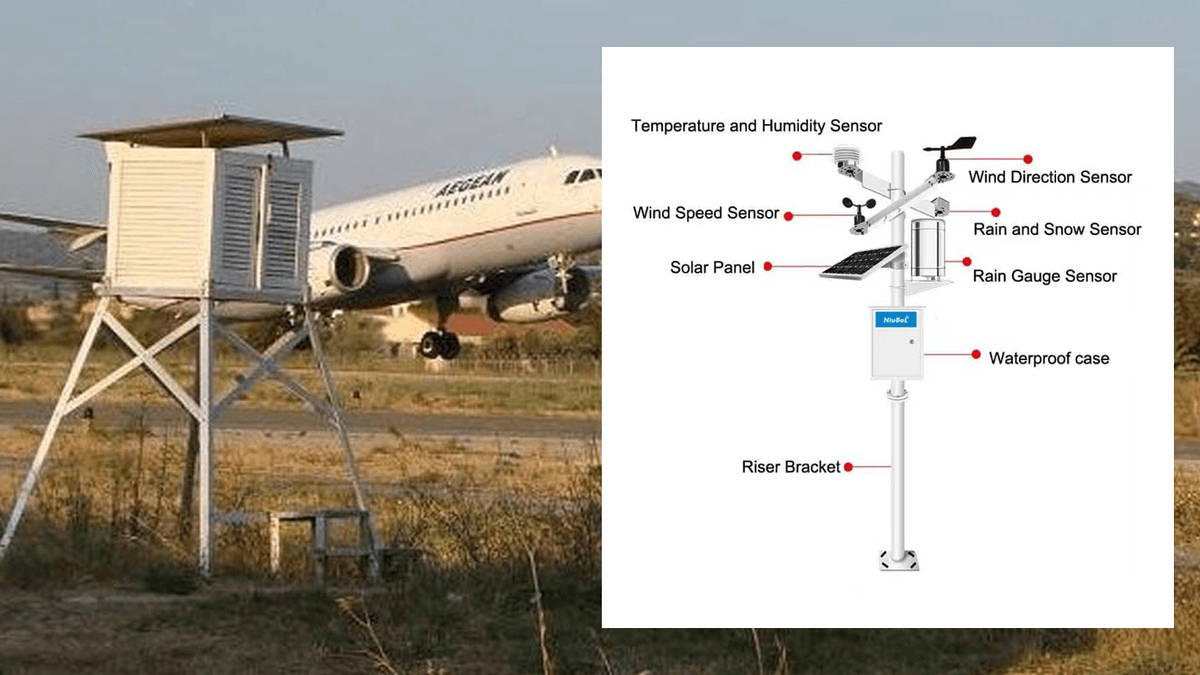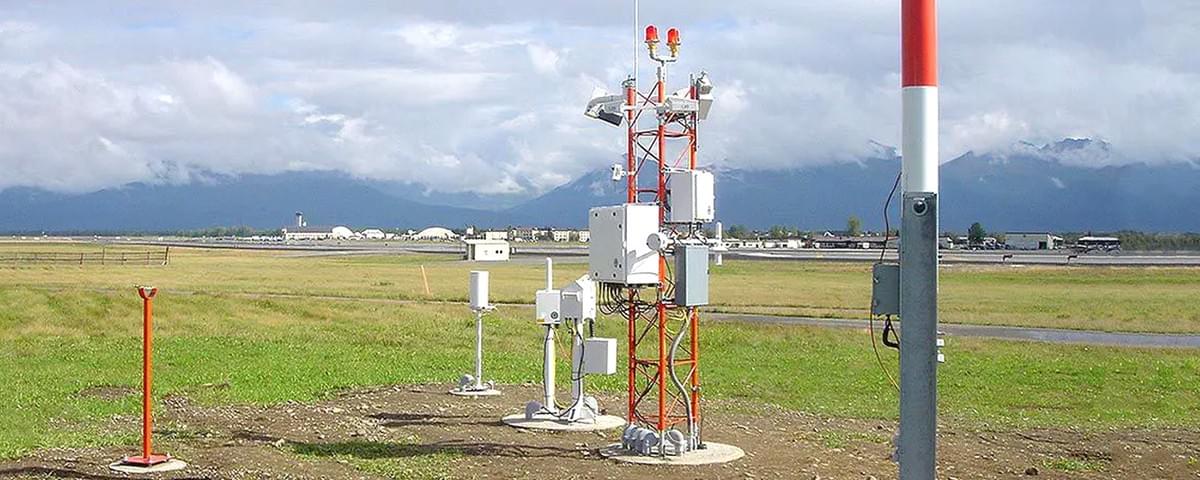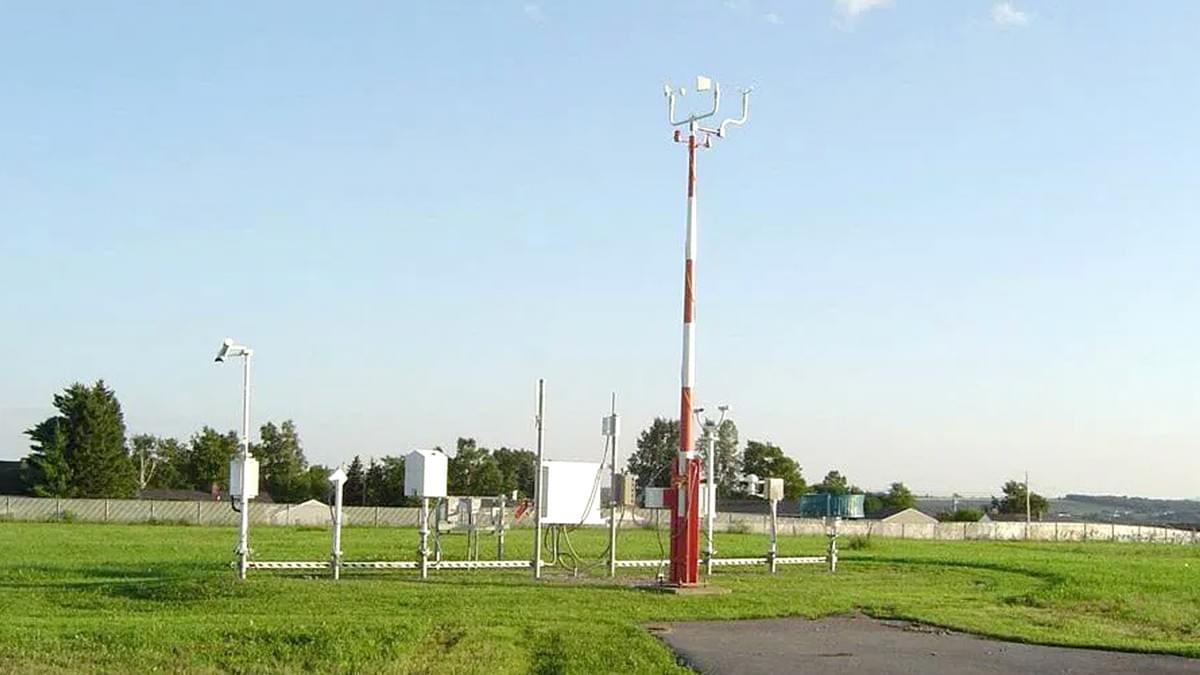An airport weather station is the backbone of safe and efficient air travel. Without a reliable airport weather station, pilots, airlines, and air traffic controllers would be blind to the meteorological conditions that directly impact flight operations. From measuring wind speed to predicting sudden storms, an airport weather station collects, processes, and delivers real-time data that keeps skies safe and schedules on track. In this comprehensive guide, we’ll explore everything you need to know about airport weather stations—how they work, why they matter, the technology behind them, and how investing in a high-quality airport weather station can transform your aviation operations.
What Is an Airport Weather Station?
An airport weather station, often referred to by acronyms like AWOS (Automatic Weather Observation System) or ASOS (Automated Surface Observing System), is a specialized network of instruments and software designed to monitor and report meteorological conditions at airports. Unlike general weather stations, an airport weather station is built to meet the strict standards of aviation, where even minor weather changes can have major consequences.
At its core, an airport weather station is a data-collection powerhouse. It continuously measures critical parameters such as wind speed and direction, atmospheric pressure, humidity, temperature, precipitation, visibility, and even cloud height. This data is not just collected—it’s processed in real time and transmitted to pilots, air traffic control towers, airlines, and weather forecasting centers. For example, when a pilot is preparing to land, the airport weather station sends instant updates on crosswinds, ensuring the aircraft can adjust its approach safely.
What sets an airport weather station apart from other weather monitoring systems is its precision. Aviation requires data accuracy down to fractions of a unit—wind speed measured in knots, temperature in degrees Celsius, and pressure in hectopascals. An airport weather station is calibrated to meet these exacting standards, often adhering to guidelines set by international bodies like the International Civil Aviation Organization (ICAO). This precision is non-negotiable: a 5-knot error in wind speed could mean the difference between a smooth landing and a dangerous incident.
Whether it’s a small regional airport or a major international hub, every aviation facility relies on an airport weather station. Even remote airstrips in challenging environments—from mountainous regions to coastal areas—depend on an airport weather station to provide the data needed to keep flights moving. In short, an airport weather station is not just a piece of equipment; it’s a critical infrastructure component that makes modern air travel possible.
Why Every Airport Needs a Reliable Airport Weather Station
The importance of a reliable airport weather station cannot be overstated. For aviation, weather is the single most significant variable affecting safety and efficiency—and an airport weather station is the first line of defense against weather-related disruptions. Let’s break down why an airport weather station is indispensable.
Safety First: Protecting Lives and Aircraft
Safety is the top priority in aviation, and an airport weather station is a key player in maintaining it. Pilots rely on data from the airport weather station to make life-or-death decisions. For instance, if the airport weather station detects sudden wind shear—a rapid change in wind speed or direction—it alerts the pilot immediately, allowing them to abort a landing or takeoff. Without this real-time data, such hazards could go undetected, leading to catastrophic accidents.
Icing is another critical risk, especially during cold weather. An airport weather station measures humidity and temperature, helping predict when ice might form on aircraft wings. This information lets ground crews de-ice planes before departure, preventing dangerous loss of lift during flight. Similarly, fog can reduce visibility to near-zero, but an airport weather station tracks visibility levels, letting air traffic control decide when it’s safe to allow takeoffs or landings.
Efficiency: Minimizing Delays and Costs
Airlines lose billions annually to weather-related delays. An airport weather station helps reduce these losses by providing accurate, timely data that allows for better planning. For example, if the airport weather station predicts a thunderstorm in two hours, airlines can adjust departure times, re-route flights, or reschedule crews—avoiding the chaos of last-minute cancellations.
Air traffic controllers also depend on the airport weather station to manage air traffic flow. During heavy rain, the airport weather station might report reduced visibility, prompting controllers to space out landings to give pilots more time to adjust. This not only keeps flights safe but also prevents backups in the air and on the tarmac, saving fuel and reducing passenger frustration.
Regulatory Compliance
Aviation is one of the most regulated industries in the world, and many countries require airports to maintain a certified airport weather station. Organizations like ICAO and the Federal Aviation Administration (FAA) mandate specific weather monitoring standards, and an airport weather station that meets these standards ensures compliance. Failure to have a functional airport weather station can result in fines, operational restrictions, or even the closure of the airport.

How an Airport Weather Station Works: From Data Collection to Action
An airport weather station is a complex system that turns raw environmental data into actionable insights. Let’s walk through its workflow step by step, highlighting how each component contributes to the overall function of the airport weather station.
Step 1: Data Collection with Specialized Instruments
At the heart of every airport weather station are the instruments that measure weather parameters. These instruments are carefully positioned around the airport—often near runways, taxiways, or observation towers—to ensure they capture conditions relevant to flight operations.
- Anemometers: These devices, a staple in any airport weather station, measure wind speed and direction. They come in various types, including cup anemometers (for speed) and wind vanes (for direction), and are calibrated to detect even subtle changes—critical for determining crosswinds during takeoff.
- Barometers: An airport weather station uses barometers to track atmospheric pressure. Pressure changes can signal approaching storms, so this data is vital for short-term forecasting.
- Hygrometers: Humidity levels are measured by hygrometers in the airport weather station. High humidity can lead to fog or icing, making this data essential for safety.
- Thermometers: Temperature affects air density, which in turn impacts aircraft lift. The airport weather station’s thermometers provide precise temperature readings to help pilots calculate takeoff and landing speeds.
- Visibility Sensors: These instruments, part of the airport weather station, measure how far pilots can see, often using laser or infrared technology to detect fog, smoke, or precipitation.
- Precipitation Gauges: The airport weather station includes gauges to measure rain, snow, or sleet, helping predict runway conditions (e.g., wet or icy surfaces).
Each instrument in the airport weather station works in tandem, sending data to a central processing unit dozens of times per minute.
Step 2: Data Processing and Validation
Raw data from the airport weather station’s instruments is useless without processing. The station’s software filters out noise, corrects for instrument drift, and cross-references readings to ensure accuracy. For example, if the airport weather station’s thermometer shows a sudden 10°C spike, the software might check the humidity reading—if humidity is low, it could indicate a sensor error, prompting a recheck.
This validation step is crucial because aviation decisions depend on trust in the airport weather station’s data. Many modern airport weather stations use machine learning algorithms to improve accuracy over time, learning from past errors to refine future readings.
Step 3: Data Distribution
Once validated, the airport weather station’s data is distributed to all stakeholders. Pilots receive it via in-cockpit displays or pre-flight briefings. Air traffic controllers see real-time updates on their screens, allowing them to adjust flight paths. Airlines integrate the data into their operations systems to optimize schedules. Even weather forecasters use the airport weather station’s data to improve regional forecasts.
Distribution happens via secure, high-speed networks, often using protocols defined by ICAO to ensure compatibility across international borders. For example, an airport weather station in London can share data with a flight departing from New York, ensuring the crew is aware of conditions at their destination.
Key Components of a High-Quality Airport Weather Station
Not all airport weather stations are created equal. A high-quality airport weather station combines durable hardware, advanced software, and seamless integration capabilities. Let’s explore the key components that set top-tier airport weather stations apart.
Durable, Weather-Resistant Hardware
An airport weather station operates 24/7, exposed to extreme conditions—blistering heat, freezing cold, heavy rain, snow, and high winds. Its hardware must withstand these elements. For example, anemometers in a premium airport weather station are made from corrosion-resistant materials like stainless steel, ensuring they function reliably even in coastal areas with salt-laden air.
Sensors in a high-quality airport weather station are also designed for low maintenance. They self-diagnose issues, sending alerts to technicians when calibration is needed. This reduces downtime and ensures the airport weather station remains operational when it’s needed most—during severe weather.
Advanced Software for Real-Time Analysis
The software in an airport weather station is where data becomes intelligence. Top systems use AI to predict short-term weather changes, such as when fog might roll in or when wind shear could occur. This predictive capability gives pilots and controllers extra time to react.
User-friendly interfaces are another hallmark of a superior airport weather station. Controllers and pilots need to interpret data quickly, so the software presents information in clear, visual formats—graphs, color-coded alerts, and easy-to-read metrics. For example, an airport weather station might highlight a sudden drop in visibility with a red warning, ensuring it’s noticed immediately.
Integration with Existing Systems
A great airport weather station doesn’t operate in a silo. It integrates seamlessly with air traffic control systems, airline operations software, and national weather databases. This integration ensures that data from the airport weather station is accessible wherever it’s needed, without duplication or delays.
Take Haisen’s BHZG01 Aviation Automatic Weather Observation Station, for example. This advanced airport weather station supports ICAO-defined communication standards, making it easy to integrate with existing infrastructure. Airports don’t need to replace their current systems to use it—they simply add the BHZG01, enhancing their capabilities without costly overhauls. This kind of compatibility is a key feature of a high-quality airport weather station.
Haisen’s BHZG01: A Leading Airport Weather Station
When it comes to reliable, high-performance airport weather stations, Haisen’s BHZG01 stands out. Designed specifically for aviation, this airport weather station combines cutting-edge technology with user-centric features, making it a top choice for airports worldwide.
Key Features of the BHZG01 Airport Weather Station
- ICAO Compliance: The BHZG01 meets all ICAO standards, ensuring it works seamlessly with international aviation systems. This is critical for airports serving international flights, as data from the airport weather station must be understandable and trusted across borders.
- Comprehensive Data Collection: Like all top airport weather stations, the BHZG01 measures wind, pressure, humidity, temperature, visibility, and precipitation. Its sensors are calibrated to deliver accuracy within 0.1 knots for wind speed and 0.1°C for temperature—precision that matters for aviation.
- Easy Integration: The BHZG01 integrates with existing air traffic control systems, saving airports time and money. There’s no need to train staff on全新 systems; the airport weather station works with the tools they already use.
- Remote Monitoring: Technicians can monitor and calibrate the BHZG01 remotely, reducing the need for on-site visits. This is especially valuable for remote airports where sending a technician can be time-consuming and costly.
- AI-Powered Predictions: The BHZG01 uses artificial intelligence to forecast weather changes up to 30 minutes in advance. This gives pilots and controllers a crucial window to adjust plans, minimizing disruptions.

Why Airports Choose the BHZG01 Airport Weather Station
Airports that switch to the BHZG01 report significant improvements in safety and efficiency. One regional airport in Europe, for example, reduced weather-related delays by 40% after installing the BHZG01. Pilots praised the airport weather station’s accurate wind shear alerts, which helped them avoid dangerous situations during takeoff.
Another airport in Asia noted that the BHZG01’s integration capabilities simplified their operations. “We used to struggle with data silos—our old weather station didn’t talk to our air traffic system,” said an operations manager. “With the BHZG01, the airport weather station feeds data directly to our controllers, making their jobs easier and our flights safer.”
For airports looking to upgrade their weather monitoring, the BHZG01 is more than an airport weather station—it’s an investment in reliability, safety, and efficiency.
Maintaining and Calibrating Your Airport Weather Station
Even the best airport weather station needs regular maintenance to stay accurate. Neglecting upkeep can lead to faulty readings, which put flights at risk and cause unnecessary delays. Here’s how to ensure your airport weather station remains in top condition.
Regular Inspections
A routine inspection schedule is essential for any airport weather station. Technicians should check sensors for damage—e.g., a bent anemometer vane or a clogged precipitation gauge—at least once a month. They should also clean sensors to remove dirt, dust, or debris that could interfere with readings. For example, a hygrometer in an airport weather station can give false humidity readings if its sensor is covered in dust.
Calibration: Keeping Readings Accurate
Calibration ensures that the airport weather station’s instruments measure correctly against known standards. For example, a barometer in the airport weather station is calibrated using a reference pressure source to ensure its readings match actual atmospheric pressure.
Most airport weather stations, including the BHZG01, require calibration every 6–12 months. However, calibration should be done more frequently after extreme weather events—like a hurricane or blizzard—that could knock sensors out of alignment.
Software Updates
The software in your airport weather station needs regular updates to fix bugs, improve accuracy, and add new features. Manufacturers like Haisen provide ongoing support for their airport weather stations, releasing updates that enhance performance and compatibility with new systems. Failing to update software can leave your airport weather station vulnerable to errors or security risks.
How Airport Weather Station Data Improves Flight Operations
The data from an airport weather station doesn’t just sit in a database—it drives real-world decisions that make flights safer and more efficient. Let’s look at specific examples of how airport weather station data transforms aviation operations.
Takeoff and Landing Decisions
Pilots use data from the airport weather station to calculate critical parameters for takeoff and landing. For instance, temperature and pressure affect air density: in hot weather, air is less dense, so planes need longer runways to take off. The airport weather station provides the temperature and pressure data pilots need to adjust their takeoff speed and runway length.
Wind is another key factor. A crosswind (wind blowing perpendicular to the runway) can make landing tricky, but the airport weather station’s wind data lets pilots know if the crosswind is within safe limits. If it’s too strong, they can wait for conditions to improve or switch to a different runway.
Route Planning
Airlines use data from multiple airport weather stations to plan flight routes. For example, a flight from Paris to New York will check the airport weather station at Charles de Gaulle, at JFK, and at waypoints in between. If the airport weather station in Boston reports a storm, the airline can reroute the flight to avoid it, saving time and fuel.
Ground Operations
Ground crews rely on the airport weather station too. If the airport weather station predicts snow, crews can pre-position plows and de-icing equipment. If humidity is high, they can schedule extra de-icing for planes to prevent ice buildup. This proactive approach reduces delays and keeps ground operations running smoothly.
Challenges Facing Modern Airport Weather Stations
While airport weather stations are more advanced than ever, they still face challenges that can impact their performance. Understanding these challenges is key to choosing the right airport weather station and using it effectively.
Extreme Weather Events
Climate change has led to more frequent and intense weather events—like stronger hurricanes, heavier snowfalls, and longer heatwaves. These events can damage sensors in an airport weather station or overload its data-processing capabilities. For example, a sudden, heavy downpour might flood a precipitation gauge in a less robust airport weather station, leading to incorrect rainfall readings.
A high-quality airport weather station, like the BHZG01, is built to handle these extremes. Its sensors are waterproof and shock-resistant, and its software can process large volumes of data without crashing.
Data Overload
Modern airport weather stations collect more data than ever before, which can overwhelm systems that aren’t designed to handle it. This “data overload” can cause delays in processing, meaning critical information reaches pilots or controllers too late.
The solution is an airport weather station with powerful processing capabilities. The BHZG01, for example, uses a high-speed processor that handles thousands of data points per second, ensuring real-time delivery of insights.
Integration with Legacy Systems
Many airports operate legacy systems that are decades old, making it hard to integrate new airport weather stations. Incompatible software or communication protocols can prevent data from flowing smoothly between the airport weather station and air traffic control.
This is where the BHZG01’s ICAO compliance shines. It uses standard protocols, so it works with both new and old systems, eliminating integration headaches.

Future Trends in Airport Weather Station Technology
The future of airport weather stations is exciting, with innovations that promise to make them even more accurate, efficient, and user-friendly. Here are the trends to watch.
AI and Machine Learning
AI will play an even bigger role in airport weather stations, enabling more precise predictions. For example, an airport weather station with advanced AI could analyze historical data to predict fog formation with 90% accuracy, giving airports hours of warning instead of minutes.
IoT Integration
The Internet of Things (IoT) will connect airport weather stations to other sensors around the airport—e.g., runway surface sensors or aircraft-mounted weather instruments. This network of data will provide a more complete picture of conditions, making the airport weather station’s insights even more valuable.
Sustainability
Future airport weather stations will be more eco-friendly, using solar power or wind energy to reduce their carbon footprint. They’ll also be designed for longer lifespans, reducing waste from frequent replacements.
Enhanced Connectivity
5G technology will allow airport weather stations to transmit data faster and more reliably, even in remote areas. This will ensure that data from the airport weather station reaches everyone who needs it—no matter where they are.
Why Invest in a High-Quality Airport Weather Station
Investing in a top-tier airport weather station is one of the best decisions an airport or airline can make. Here’s why:
- Safety: A reliable airport weather station reduces the risk of weather-related accidents, protecting passengers, crew, and aircraft.
- Cost Savings: By minimizing delays and cancellations, an airport weather station saves airlines millions in operational costs.
- Regulatory Compliance: A certified airport weather station ensures your airport meets international standards, avoiding fines and restrictions.
- Reputation: Airports with a track record of on-time flights and safe operations attract more airlines and passengers, boosting revenue.
For airports looking to upgrade, the BHZG01 is an excellent choice. Its combination of accuracy, durability, and integration capabilities makes it a long-term investment in aviation excellence.
Ready to Upgrade Your Airport Weather Station?
Your airport’s weather monitoring system is too important to leave to chance. A high-quality airport weather station—like Haisen’s BHZG01—provides the data you need to keep flights safe, efficient, and on schedule.
Whether you’re a small regional airport or a major international hub, we can help you find the perfect airport weather station for your needs. Contact our team today to learn more about the BHZG01 and how it can transform your operations. Let’s keep your skies safe—together.
Invest in a reliable airport weather station. Invest in safety. Invest in efficiency. Contact Haisen now.

